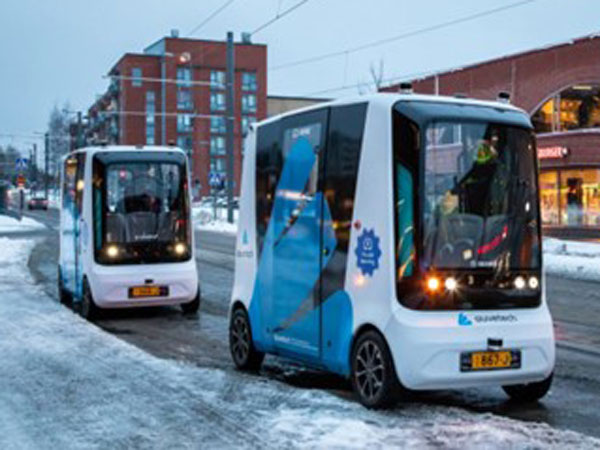A master’s thesis conducted at VTT Technical Research Centre of Finland Ltd. has investigated the impact of introducing automated shuttle buses in the current transportation system. The study concentrated on assessing the effects of a connected and automated shuttle bus travelling on a lane shared with a tram and examining traffic management interventions.

Automated shuttle buses in Tampere, Finland. Photo: Auve Tech.
The study used microsimulations to assess the influences of two traffic management interventions, tram warning and Green Light Optimized Speed Advisory (GLOSA). Multimodal traffic data was analyzed and incorporated into the simulation to examine the impacts of an automated shuttle in a real urban setting. Traffic simulations were conducted with the microsimulation tool PTV Vissim. The simulation model was based on the characteristics of the study area in Hervanta, Tampere, where pilot tests with the automated shuttle have taken place. Part of the automated shuttle bus route is on a lane shared with the tram.
Hervanta is a suburban area home to nearly 26,000 residents. The study area has a well-connected transportation system for different travel modes. A relatively new tram line is among them, providing easy access to the city centre. The city strives for climate neutrality and intends for new mobility services, like demand-responsive transport in low-demand areas, to enhance the convenience of everyday mobility and improve public transport ridership.
Automated shuttle bus impedes the movement of high-speed public transport
According to scenario-based analysis, a slow-moving automated shuttle bus in a shared lane with a tram increases the tram’s travel time. A tram warning application in the shuttle bus guarantees uninterrupted movement of the tram. However, it increases the travel time of the shuttle, which has to wait at a bus stop while the tram operates in the shared lane. Conversely, the GLOSA system does not significantly impact traffic performance if only the shuttle receives a speed suggestion at intersections.
The potential of integrating automated shuttle buses with existing public transport
Recent innovations in electrification and automation of public transport can be significant in shifting to sustainable travel modes. Automated shuttle buses are a novel addition to public transport and have the potential to address urban transportation challenges through last-mile mobility solutions. Advanced traffic management interventions would help integrate them effectively into the public transport system and avoid interruptions.
The IN2CCAM project’s funding from the European Commission Horizon 2020 research and innovation programme (grant agreement number 101076791) enabled the study to be carried out.
Read the full thesis:
Nino Chkhartishvili (2024). Effects of an automated shuttle bus on urban traffic in Tampere, Finland.
University of Helsinki, 2024.
Contact

Nino Chkhartishvili
nino.chkhartishvili@vtt.fi
VTT Technical Research Centre of Finland Ltd, Finland






Follow us: